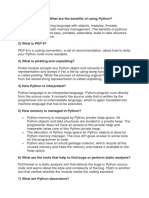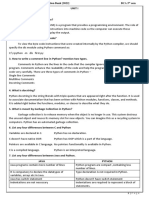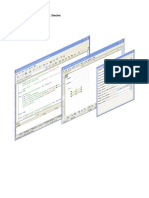0 ratings0% found this document useful (0 votes)
11 viewsWho Is The Developer of Python
Uploaded by
dmanathome69Copyright
© © All Rights Reserved
Available Formats
Download as PDF, TXT or read online on Scribd
0 ratings0% found this document useful (0 votes)
11 viewsWho Is The Developer of Python
Uploaded by
dmanathome69Copyright
© © All Rights Reserved
Available Formats
Download as PDF, TXT or read online on Scribd
You are on page 1/ 12
1. Who is the developer of Python?
Answer: Guido van Rossum
2. Which special character is used for a new line?
Answer: \n
3. Python commands are evaluated/executed in _______.
Answer: Interpreter
4. The symbol used for a single-line comment in Python.
Answer: # (hash symbol)
5. Python statement that forces a specified exception to occur.
Answer: raise
6. ELSE keyword is used in exception handling in Python
(True/False).
Answer: True
7. ______ exception catches all exceptions in Python.
Answer: BaseException
8. Partition and exchange sort is _______.
Answer: Quick Sort
9. Knapsack problem is also known as ______ problem.
Answer: 0/1 Problem
10. The method to display the graphical window on the
computer screen.
Answer: show()
11. Default file extension for storing PyLab Figure is _______.
Answer: .fig
12. The function to save a plot graph to a file in Python.
Answer: savefig()
13. URL stands for ______.
Answer: Uniform Resource Locator
14. UDP stands for ______.
Answer: User Datagram Protocol
15. TCL stands for ______.
Answer: Tool Command Language
16. TCP/IP stands for _______.
Answer: Transmission Control Protocol/Internet Protocol
17. SQL stands for _______.
Answer: Structured Query Language
18. Which package is used to connect a MySQL database in
Python?
Answer: mysql-connector-python
19. List out the parameters of the connection() function.
Answer: host, user, password, database
20. Which method of the cursor class fetches only one row
from the table?
Answer: fetchone()
21. IDLE stands for _______.
Answer: Integrated Development and Learning Environment
22. The symbol used as a shell prompt in Python.
Answer: >>> (three greater-than signs)
23. The method to read a string from an open file in Python.
Answer: read()
24. ADT stands for ________.
Answer: Abstract Data Type
25. Brief description about the class is given by _______.
Answer: docstring
26. The error raised when division or modulo by zero occurs.
Answer: ZeroDivisionError
27. PyLab is embedded with the ______ module of Python.
Answer: Matplotlib
28. Give the full form of PNG.
Answer: Portable Network Graphics
29. Dynamic programming is an optimization over plain
_______.
Answer: Recursion
30. The function used to display a chart/figure in Python.
Answer: show()
31. JSON stands for _______.
Answer: JavaScript Object Notation
32. CSV stands for _______.
Answer: Comma-Separated Values
33. RegEx stands for _______.
Answer: Regular Expression
34. If there is no match, _______ will be returned instead of
the Match object.
Answer: None
35. ROC stands for __________.
Answer: Receiver Operating Characteristic
36. MAE stands for ______.
Answer: Mean Absolute Error
37. AUC stands for ______.
Answer: Area Under the Curve
38. MSE stands for ______.
Answer: Mean Squared Error
39. The function used to save plots to files in Python is
_______.
Answer: savefig()
40. The symbol used for multi-line comments in Python is
_______.
Answer: ''' (triple single quotes) or """ (triple double quotes)
41. IDLE stands for _______.
Answer: Integrated Development and Learning Environment
42. ______ is the inventor of Python.
Answer: Guido van Rossum
43. Default extension of a Python file is _______.
Answer: .py
44. ______ is a container for storing basic data values.
Answer: Variable
45. ADT stands for _______.
Answer: Abstract Data Type
46. ______ statement forces an exception to occur.
Answer: raise
47. ______ catches all exceptions.
Answer: BaseException
48. ______ block executes code, whether an exception occurs
or not.
Answer: finally
49. ______ function is used to create a new figure.
Answer: figure()
50. ______ function is used to display a plot.
Answer: show()
51. ______ function is used to save a plot file.
Answer: savefig()
52. An example of a sorting algorithm that uses the divide-
and-conquer approach is ______ sort.
Answer: Quick Sort
53. The ______ module is commonly used for socket
programming to handle network connection.
Answer: socket
54. The ______ method is used to associate the socket with a
specific network interface and port number.
Answer: bind()
55. The ______ protocol is used to send email over the
internet.
Answer: SMTP (Simple Mail Transfer Protocol)
56. The "socket.gethostname()" function in Python returns the
______ of the machine.
Answer: Hostname
57. ______ method is used to call existing procedures of
MySQL database.
Answer: callproc()
58. ______ method gives information about the last query.
Answer: info()
59. ______ method accepts a MySQL query as a parameter
and executes the given query.
Answer: execute()
60. ______ method fetches the next row in the result of a
query and returns it as a tuple.
Answer: fetchone()
1) Explain tuple with an example.
Answer: A tuple is an immutable sequence in Python, used to
store multiple items in a single variable. Tuples are created
using parentheses, e.g., my_tuple = (1, 2, 3). Tuples cannot
be modified after creation, making them useful for storing
constant values.
2) What is a global variable?
Answer: A global variable is one that is defined outside any
function and can be accessed in any function within the code.
It is declared in the global scope, so functions can read or
modify it using the global keyword if needed.
3) Explain assertions in Python.
Answer: Assertions are debugging aids that check if a
condition is True. If not, Python raises an AssertionError. They
are used for sanity checks and are written using assert, e.g.,
assert x > 0, "x should be positive".
4) What is a class in Python?
Answer: A class in Python is a blueprint for creating objects,
encapsulating data (attributes) and functions (methods). Classes
are defined using the class keyword, e.g., class Car: which
then can be instantiated as objects.
5) Explain the show() function in Python.
Answer: The show() function in libraries like Matplotlib displays
a graphical plot or chart on the screen. After plotting data,
calling show() renders the plot.
6) Explain the legend() function in Python.
Answer: In Matplotlib, legend() adds a legend to the plot,
which is a small box describing elements of the chart. Labels
are automatically assigned if specified in plot().
7) Write code to download an image from the internet in
Python.
8) Explain the Button widget with an example.
Answer: The Button widget in Tkinter is used to create
clickable buttons in a GUI application
9) Write a Python code to insert a record in a table.
Answer:
a)
10) Write a Python code to delete a record from a table.
Answer:
a)
11) Explain recursion in Python.
Answer: Recursion is a function calling itself to solve a
problem in smaller parts. For instance, calculating factorial
using def factorial(n): return 1 if n == 0 else n * factorial(n-1).
12) Explain tuple with an example.
Answer: Tuples are immutable collections of items, e.g.,
example_tuple = ('apple', 'banana'). They are used to store
data that should not be changed.
13) What is the self keyword in Python? Explain with an
example.
Answer: self represents the instance of the class in Python,
allowing access to attributes and methods of the class.
Example:
14) Explain binary search with an example.
Answer: Binary search is an efficient algorithm for finding a
target value in a sorted list by repeatedly dividing the search
range in half. Example:
15) Explain the figure() function in Python.
Answer: figure() in Matplotlib creates a new figure window for
plotting. It allows customization like figure size and title before
plotting.
16) Explain the plot() function in Python.
Answer: plot() in Matplotlib is used to plot lines and data
points. It accepts x and y values, and styles, e.g., plot(x, y, 'g-
').
17) Explain the difference between search() and findall() in
Python.
Answer: In re module, search() finds the first match in a string,
while findall() returns all matches as a list.
18) List out all flags modifiers with a single-line meaning.
Answer:
a) re.IGNORECASE: Ignores case
b) re.MULTILINE: Matches start/end in multiple lines
c) re.DOTALL: Allows . to match newline
19) Explain the head() function in Python.
Answer: In pandas, head() returns the first five rows of a
DataFrame, allowing a quick view of the data.
20) Explain the tail() function in Python.
Answer: In pandas, tail() returns the last five rows of a
DataFrame for quick review of the dataset's end.
21) Explain TUPLE with example.
Answer: Tuples store multiple items in one variable. Example:
example_tuple = (1, 2, 'apple').
22) Explain LIST data type.
Answer: Lists are mutable sequences in Python, used to store
multiple items. Defined using square brackets, e.g., my_list =
[1, 2, 3].
23) Explain AttributeError.
Answer: AttributeError occurs when an attribute reference or
assignment fails, typically due to a missing attribute in an
object.
24) Explain ValueError.
Answer: ValueError occurs when an operation receives an
argument of correct type but inappropriate value, e.g.,
int("abc").
25) Explain pylab.title, xlabel and ylabel.
Answer: In Matplotlib:
a) title(): Adds title to the plot.
b) xlabel(): Labels x-axis.
c) ylabel(): Labels y-axis.
26) What is Memoization?
Answer: Memoization is an optimization technique where
function results are cached for reuse, reducing repeated
computations.
27) Explain socket.bind().
Answer: socket.bind() associates the socket with a specific IP
and port, essential for servers to receive connections.
28) Explain socket.connect().
Answer: socket.connect() establishes a connection to a server
socket, specifying the server's IP address and port.
29) Explain lastrowid in a statement.
Answer: lastrowid retrieves the ID of the last inserted row in a
database, useful for referencing newly added entries.
30) Explain column_names and description.
Answer: In MySQL, column_names lists all column headers in
a table, while description provides metadata like column names
and types.
You might also like
- Oracle Database Workshop 1: by Hari Krishna MakkiniNo ratings yetOracle Database Workshop 1: by Hari Krishna Makkini73 pages
- Python Questions for Cloudy Coders DriveNo ratings yetPython Questions for Cloudy Coders Drive28 pages
- Python Interview Questions For Freshers - Docx 1No ratings yetPython Interview Questions For Freshers - Docx 16 pages
- Python Sample Viva Questions for Academic Session 2024-2025No ratings yetPython Sample Viva Questions for Academic Session 2024-20256 pages
- Comprehensive Python Question Bank with AnswersNo ratings yetComprehensive Python Question Bank with Answers10 pages
- 1) What Is Python? What Are The Benefits of Using Python?No ratings yet1) What Is Python? What Are The Benefits of Using Python?28 pages
- Elaborate All Questions From First to Last on Firs...No ratings yetElaborate All Questions From First to Last on Firs...4 pages
- Python Interview Questions and Answers for FreshersNo ratings yetPython Interview Questions and Answers for Freshers7 pages
- Programming in Python Mcqs With Answers (2022) CsdNo ratings yetProgramming in Python Mcqs With Answers (2022) Csd63 pages
- python programming question bank unit wise by Rupesh ✓No ratings yetpython programming question bank unit wise by Rupesh ✓24 pages
- Python Important Questions For Mid Term Exam..No ratings yetPython Important Questions For Mid Term Exam..10 pages
- Python programming interview questions and answers pdfNo ratings yetPython programming interview questions and answers pdf6 pages
- HIGH_chances_pyton_qustion_answer_in_2024No ratings yetHIGH_chances_pyton_qustion_answer_in_202418 pages
- Python Advanced Programming: The Guide to Learn Python Programming. Reference with Exercises and Samples About Dynamical Programming, Multithreading, Multiprocessing, Debugging, Testing and MoreFrom EverandPython Advanced Programming: The Guide to Learn Python Programming. Reference with Exercises and Samples About Dynamical Programming, Multithreading, Multiprocessing, Debugging, Testing and MoreNo ratings yet
- Module 4_(Process Data from Dirty to Clean)No ratings yetModule 4_(Process Data from Dirty to Clean)36 pages
- Local Storage Data: Android Development With Kotlin v1.0No ratings yetLocal Storage Data: Android Development With Kotlin v1.028 pages
- 2023-24 - Advanced Database Systems CSE Sem VIINo ratings yet2023-24 - Advanced Database Systems CSE Sem VII2 pages
- How To Create A New Radexpro Processing Project and Load Input DataNo ratings yetHow To Create A New Radexpro Processing Project and Load Input Data12 pages
- SQL Commands : Create The Database Loans. Use Database LoansNo ratings yetSQL Commands : Create The Database Loans. Use Database Loans9 pages
- Chapter6_NormalizationDatabaseTables_Part4 (2)No ratings yetChapter6_NormalizationDatabaseTables_Part4 (2)38 pages
- Communications Data Model Datasheet 131313No ratings yetCommunications Data Model Datasheet 1313134 pages
- The Ultimate Guide To IBM Certified Solution Architect - Watson Internet of Things Platform V1No ratings yetThe Ultimate Guide To IBM Certified Solution Architect - Watson Internet of Things Platform V13 pages
- My Courses: Home Dbw301 - Phuonglh17 16 March - 22 March Progress Test 2 - Is1208No ratings yetMy Courses: Home Dbw301 - Phuonglh17 16 March - 22 March Progress Test 2 - Is12082 pages
- Relational Database Design: Converting Conceptual Models To Relational DatabasesNo ratings yetRelational Database Design: Converting Conceptual Models To Relational Databases31 pages
- Oracle Database Workshop 1: by Hari Krishna MakkiniOracle Database Workshop 1: by Hari Krishna Makkini
- Python Sample Viva Questions for Academic Session 2024-2025Python Sample Viva Questions for Academic Session 2024-2025
- 1) What Is Python? What Are The Benefits of Using Python?1) What Is Python? What Are The Benefits of Using Python?
- Elaborate All Questions From First to Last on Firs...Elaborate All Questions From First to Last on Firs...
- Python Interview Questions and Answers for FreshersPython Interview Questions and Answers for Freshers
- Programming in Python Mcqs With Answers (2022) CsdProgramming in Python Mcqs With Answers (2022) Csd
- python programming question bank unit wise by Rupesh ✓python programming question bank unit wise by Rupesh ✓
- Python programming interview questions and answers pdfPython programming interview questions and answers pdf
- Oracle Certified Professional Java Programmer OCPJP 1Z0 809From EverandOracle Certified Professional Java Programmer OCPJP 1Z0 809
- Python Interview Questions You'll Most Likely Be AskedFrom EverandPython Interview Questions You'll Most Likely Be Asked
- Python Advanced Programming: The Guide to Learn Python Programming. Reference with Exercises and Samples About Dynamical Programming, Multithreading, Multiprocessing, Debugging, Testing and MoreFrom EverandPython Advanced Programming: The Guide to Learn Python Programming. Reference with Exercises and Samples About Dynamical Programming, Multithreading, Multiprocessing, Debugging, Testing and More
- Local Storage Data: Android Development With Kotlin v1.0Local Storage Data: Android Development With Kotlin v1.0
- How To Create A New Radexpro Processing Project and Load Input DataHow To Create A New Radexpro Processing Project and Load Input Data
- SQL Commands : Create The Database Loans. Use Database LoansSQL Commands : Create The Database Loans. Use Database Loans
- The Ultimate Guide To IBM Certified Solution Architect - Watson Internet of Things Platform V1The Ultimate Guide To IBM Certified Solution Architect - Watson Internet of Things Platform V1
- My Courses: Home Dbw301 - Phuonglh17 16 March - 22 March Progress Test 2 - Is1208My Courses: Home Dbw301 - Phuonglh17 16 March - 22 March Progress Test 2 - Is1208
- Relational Database Design: Converting Conceptual Models To Relational DatabasesRelational Database Design: Converting Conceptual Models To Relational Databases

























































































